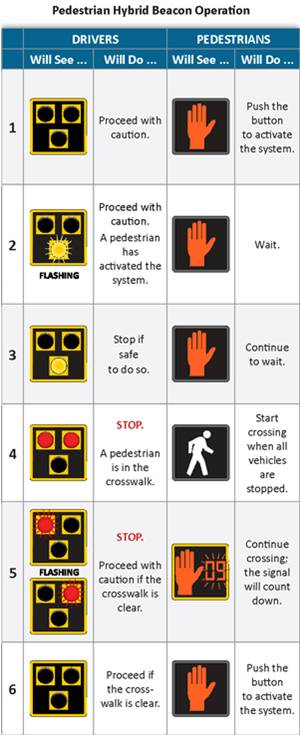Safety issue
It is often difficult for pedestrians to cross roads with high traffic volumes, especially roads with higher vehicle speeds. Sometimes regular traffic signals cannot be used because of spacing requirements between signals or the amount of pedestrian or side-street traffic is not high enough to justify a signal.
Safety design
A pedestrian hybrid beacon is used to warn and control traffic at a mid-block crosswalk without other traffic signals. While slightly different in appearance, this beacon functions much like a conventional pedestrian signal in that it stops traffic to allow pedestrians to cross safely.
The beacon stops traffic with a double red indication thereby creating a gap for pedestrians to cross. The following videos help illustrate how a hybrid beacon operates.
Benefits
- The alternating red signal indication allows vehicles to proceed once the pedestrian has cleared their side of the travel lane, thus improving vehicle traffic flow.
- According to Federal Highway Administration (FHWA) pedestrian hybrid beacons can reduce delays for pedestrians by up to 50 percent when compared to traditional signalized crossings.
Where are they being used?
- Pedestrian hybrid beacons should only be used with a marked crosswalk.
- These beacons are used if gaps in traffic are not adequate to permit pedestrians to cross safely.
- Transit and school locations may be good places to use the pedestrian hybrid beacon.
Pedestrian hybrid beacon operation
- The beacon is DARK for
motorists UNTIL
pedestrians/bicyclists push the button to activate it AND
pedestrians/bicyclists approaching the crosswalk see a steady "Don't Walk" indication.
- When
pedestrians/bicyclists press the button:
-
Motorists will see a FLASHING YELLOW indication for a few seconds, signaling that the beacon has been activated and motorists must proceed with caution.
-
Pedestrians/bicyclists will continue to see a "Don't Walk" indication and must wait. If the beacon was recently activated, it might take up to one minute for the "Walk" indication to come up.
- The flashing yellow is followed by a SOLID YELLOW indication.
-
Motorists should stop if able to safely do so.
-
Pedestrians/bicyclists will continue to see a "Don't Walk" indication and must continue to wait.
- The solid yellow is followed by double SOLID RED indications.
-
Motorists are required to come to a full STOP if they have not done so already.
-
Pedestrians/bicyclists receive a "WALK" indication and, if clear, begins crossing the road in the marked crosswalk.
- The double solid red is followed by alternating FLASHING RED indications (the last configuration in the sequence).
-
Motorists are required to STOP, or remain stopped, until pedestrians/bicyclists have finished crossing the street. They may proceed with caution after stopping once the crosswalk is clear of pedestrians/bicyclists.
-
Pedestrians/bicyclists already in the crosswalk continue crossing and will receive a numerical indication counting down the time remaining to finish crossing the street.
-
Newly approaching pedestrians/bicyclists may NOT start to cross on a flashing "Don't Walk" indication, even if they think they have enough time to clear – they must push the button and wait for the next "WALK" indication.
- The beacon will then go DARK again until activated by another pedestrian/bicyclist.
-
Motorists may proceed through the crosswalk if it is clear.
-
Pedestrians/bicyclists see a steady "Don't Walk" indication.